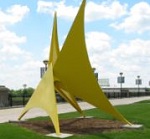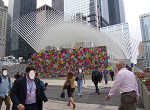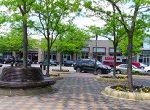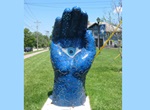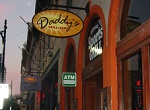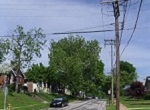Arts and Economic Development Are Complementary
Last Updated: July 6, 2024
Reasons behind the current trend toward
relating arts and economic development to one another include:
- Locally produced art cannot be outsourced, merged, or bought out. If you keep your community lively, you are relatively immune to the frustrating experience of having an entrepreneur that you have nurtured decide to relocate to other towns or cities.
- Arts are quite conducive to attracting tourism, one of the larger drivers of economic development in many parts of the U.S. and indeed the world. They can introduce vitality quickly in otherwise sterile places that would be unappealing to tourists.
- As individuals who plug into
their creativity every day, artists provide a prolific source of new
ideas for place-making, interesting events, and offbeat ideas that help
differentiate one city or district from another.
- Artists
almost always are entrepreneurs already. Now some may have part-time or even
full-time jobs, but with regard to their art, they are entrepreneurs if
they want to sell it.
- To state the obvious, a dollar spent on acquiring visual arts or attending a performance is just as good as a dollar spent on buying other stuff.
- Artists are always looking for cheap space, and plenty of it. They even find industrial grunge and abandoned or ruined buildings attractive. This makes them ideal suspects for tackling much-needed renovations of obsolete industrial space and overbuilt commercial space, or even for entire redevelopment projects that do not fit into ordinary developer business models.
- Artists can help activate other elements of the so-called creative economy, which might include entrepreneurs such as chefs, game designers, fashion designers, publishers, digital media folks, and entertainers and entertainment venues. When the definition is expanded in this way, suddenly economic development professionals and city officials may see that an arts and economic development are compatible topics, even complementary.
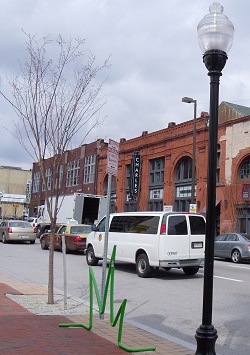
You might be asking yourself about the extent of this supposed relationship between arts and economic development.
The Arts and Economic Prosperity IV report from Americans for the Arts is a carefully researched look at the impact of the arts on the economies of a number of specific U.S. locales. The linked website also offers an online calculator for guesstimating economic impacts of non-profit arts organizations on communities that did not participate in the study, based on the population of the community. This report certainly is not all inclusive, but it is potentially quite valuable as a persuasion tool for arts and economic development advocates.
The report found that in its survey of 182 U.S. regions, the arts generated $135.2 billion, divided into $61.1 billion in spending by arts organizations and $74.1 billion in audience spending not including admission costs. This translates to $24.60 per person for each event, without counting ticket prices, so that means sales for your restaurants predominantly. Also important to you at the local level, about 32 percent of audiences traveled from outside the county.
Roles for Governments and Non-Profits Boosting the Arts as Economic Development
How to foster the development of arts and economic development differs based on whether a local government, state government, non-profit, historic preservationist, or developer is driving the program. In general, incentives tend to include creation of a cultural district (may be called an arts district or recently, an arts and entertainment district), tax credits, and donations of land or vacant buildings.
At other times the program is aimed at individual artists and might include tax credits for those individuals; grants of free space; subsidies for development of new galleries, live-work spaces, or simply artists housing; or ways for artists to claim abandoned or vacant buildings and lots.
Sadly, U.S. federal efforts on arts and economic development are slim to non-existent. The action occurs mostly on the local level, although some state governments are now giving their long-standing arts councils an expanded role in creating economic vigor. This is different for our growing group of European users, of course!
While all of programs discussed thus far are important, we will concentrate more on three approaches to arts as economic drivers that work with physical space, since this is a community development website first and foremost. Arts and economic development strategies based on organizing or improving a particular place not only assist in building the economic base, but also result in creating or maintaining vital and interesting districts or even small towns.
Those three approaches with a community development angle include arts trails, arts incubators, and arts districts. These are discussed in the next two sections.
Arts Trails and Incubators
If you want to include more artists and organizations than the district concept would allow, one way to start is to invent an art trail, implying a linear tour or loop tour more than a walkable rectangular area.
If the underlying organization is sound, a trail approach may work. Often the trail is mostly a conceptual tool to allow joint marketing brochures and such, rather than any kind of physical infrastructure linking artists and organizations. (Marker signs would improve the concept.)
To inject a note of caution, we should say that two of the best examples of this approach that we have used in our planning practice are now defunct. A New Mexico Fiber Arts Trail operated for about 10 years and was discontinued in 2018.
We emphasize the viability of the sponsoring organization because, for
example, the craft heritage trail started by Handmade in America in
western North Carolina became an orphan when the Handmade in America
organization had to close its doors for lack of funding.
Now let's look briefly at the incubator approach. One cool project in this category, administered by Midtown Partners, LLC, a Jackson, Mississippi, community development corporation, is called The Hub Midtown. The Hub consists of two facilities, The Hatch and The Hangar, both of which offer space to start-up creative businesses in former industrial type facilities. Check out their arts and economic development approach, which is less artsy in its presentation than many, but also really zeroed in on the benefits of a creative economy.
Most mechanics of the incubator would be similar to any other type of economic development incubator, so we refer you to our page on that topic as well.
Using Districts to Develop the Arts and Economic Development Linkage
Arts districts have a long history and often develop organically. Accelerating that growth purposefully, in part based on an economic motive, is a role communities have embraced with increased enthusiasm recently.
Several state governments in the U.S. are promoting the creation of arts, cultural, and entertainment districts. States as diverse as Iowa, Colorado, Massachusetts, Kentucky, Texas, and Arkansas have found this worth their while.
Among the best programs we have seen is the state of New Mexico's support for the formation of arts and cultural districts, enacted into law in 2007. The state helps considerably with funding and technical assistance for start-up planning, but it does not fund the ongoing staffing or operations that are absolutely essential.
Their newsletters about supporting the arts are very worthwhile for anyone considering establishing such a district.
The New Mexico typology of types of arts and cultural districts is right on point, and includes:
- Artist market driven---gives artists better opportunities to promote and sell their work
- Community development focus--emphasizes unique cultural character of residents
- Cultural production focus--creates new work spaces or live-work spaces
- Institution driven--expands on the benefits that large arts organizations can bring to a particular place by helping nearby smaller supporting organizations to flourish as well
- Public sector catalyst--relies on the public sector as the driver of a comprehensive approach to dispersing the benefits of arts and cultural organizations throughout the community (adapted from p. 7 of the file reached from the above link).
As with most planning on the part of non-profits and governments, clarifying community thinking and public expectations is critical to success. So decide which type of district or community project makes sense in your environment.
At the local level, cities can and should do more to strategize for and assist arts districts in a comprehensive way. The City of Seattle has established a good process for designating official arts districts. Currently there are two official districts. In an important turn of events, it looks as if the City is willing to help out with a creative place-making toolkit, although it isn't very dynamic yet. The best idea we saw there was what they call B.A.S.E. (Build ArtSpacE) Certification, which would acknowledge developments that include cultural space, much like the LEED designation recognizes buildings that incorporate great sustainability features.
Lastly, we offer several examples of the arts district approach. Bloomington Indiana's Bloomington Entertainment and Arts District is situated in their downtown area, near the flagship University of Indiana campus. This one is tricky. On the one hand, they do boast a serious contingent of visual and performing arts shops, spaces, and venues. On the other hand, they seem to us to be branding almost their entire downtown as the arts and entertainment district. That will probably result in lack of focus.
Not every single parcel of land in an arts district must be devoted to an arts use. How boring! But we think that visitors don't really want to comb through listings of elementary schools, farmer's markets, courthouses, and so forth when they are looking for information on an arts district. Internally, yes, it's important to involve as many stakeholders as possible, but externally it pays to be judicious in what you list as contributing to your arts district.
In terms of over-inclusiveness in marketing, we think Station North Arts and Entertainment District
in Baltimore, which we are really rooting for, suffers from a bit of
the same issue. (The photo on this page is Station North in its early
stages.)
Granted, sometimes an effort to brand the arts and
economic development initiative becomes a re-branding initiative for
downtown or some other district with obsolete uses. For example, the Bethesda Arts & Entertainment District
in Maryland is basically an arts and economic development project of
their downtown organization, and the state designated all of downtown as
the arts and entertainment district. To their great credit, by the
time you are clicking on Venues on their website, they do seem to have
an understanding of what is, and what is not, an arts organization. So
at least a prospective visitor has a succinct listing of the
contributing components of the arts district.
Finally, Denver's Art District on Santa Fe
is a spectacularly successful and organically grown arts district, with
no direct and sustained governmental support. This area near downtown
was really down at the heels, but when artists started buying buildings
and talking with one another, eventually getting into creative
place-making to improve the neighborhood, great success has come their
way. Now there may be a danger of pricing out the edgier artists, so
those artists may start the process somewhere else. But the Art
District on Sante Fe can remain viable and even grow a more robust
economy if the current artists in the area continue to work steadfastly
on how to keep the area lively.
Dig into some of these examples, or find them in your state or nation. While visual artists and performance organizations are not a panacea for everything wrong with employment, tourism, or old buildings in your community, incorporate cultural tourism and community cultural development into your thinking and work to create positive results from underutilized community assets.
How to Attract Artists to Live and Work in a Neighborhood
Sometimes cities try to offer free or very low-cost space to artists who will populate a neighborhood. If land values are quite low, this is practical. In Paducah, Kentucky, the city carried out a smart advertising campaign to bring artists to live in abandoned buildings within a neighborhood.
While that project is encountering some difficulties, allegedly because city services and investments have not been quite as forthcoming as some artists wanted, the model is sound.
Where there are a group of artists, there will be a group of arts-minded or bohemian shoppers, just like Automobile Row or a row of women's clothing stores. The presence of artists as residents also will mean that coffee houses, bars, and inexpensive restaurants are likely to spring up. Expect an impromptu streetscape project, a wall mural, or a flash mob of some sort. Maybe you will even experience some graffiti art that townspeople will disagree with.
Advance Planning for Arts-Based Economic Development
Often it is wise to have a longer-range plan when you create an arts-dependent community development project, or when one accidentally starts up without your being purposeful. This plan should address questions such as potential alternative locations if artists are priced out, either for studio space or living space, or both.
In addition, we suggest that you discuss the following questions:
- When the performing arts market is saturated and your hotels, restaurants, and infrastructure are at capacity, what's your next step?
- Can you then branch out into visual arts?
- If your weather is nice for part of the year, accounting for your tourism-based success in community and economic development, what can you do the rest of the year to provide your citizens a more even income?
- If the culture wars become too strong, who are the likely suspects for being able to bridge the divide between the town or the neighborhood and the newly attracted artists?
Read About Possible Next Steps in the Arts as a Community Development Tool
- Making and Keeping a Good Community >
- Community Challenges, Common Topics & Concepts >
- Economic Development > Arts and Economic Development
Join GOOD COMMUNITY PLUS, which provides you monthly with short features or tips about timely topics for neighborhoods, towns and cities, community organizations, and rural or small town environments. Unsubscribe any time. Give it a try.
